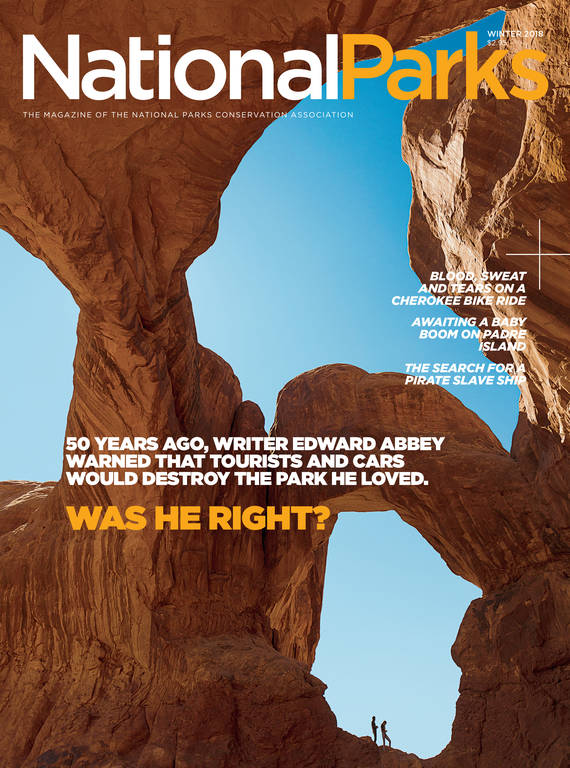Winter 2018
Total Eclipse of the Parks
Two years of planning for two minutes of wonder in the Great Smokies.
When it comes to natural phenomena, I’ve always been drawn to the uncommon. I’ve caught a glimpse of a rare super bloom in Death Valley, spied Comet Hale-Bopp from a viewpoint in Shenandoah and experienced the once-every-17-year emergence of periodical cicadas at Manassas National Battlefield. Gee-whizzery loves company, and I tend to drag friends and family along with me on these escapades that seem to lead us, more often than not, to a national park.
So it was no surprise to my son, Elijah, and daughter, Leila, when I decided on a 500-mile road trip to Great Smoky Mountains National Park to view a truly extraordinary event: the total solar eclipse of Aug. 21, 2017. They were willing companions and good sports, and even created a themed soundtrack for the journey, a Spotify playlist featuring classics like Pink Floyd’s “Dark Side of the Moon” — an album that culminates, fittingly, in an exultant song entitled “Eclipse.”
There was good cause for excitement; the last time even part of the contiguous United States saw a total solar eclipse, the lowly mix-tape was still the state of the art for compiling and sharing music. On Feb. 26, 1979, the northwestern corner of the country lay in the path of the eclipse, but widespread cloud cover mostly obstructed the view. And it had been nearly a century since a total solar eclipse was widely visible from coast to coast — June 8, 1918 — lending credence to the “once-in-a-lifetime” hoopla this time around.
The Great American Eclipse, as last summer’s cosmic event had come to be known, was indeed a uniquely American experience. Although a partial eclipse could be seen throughout the continent, the path of totality — the roughly 70-mile-wide swath where the moon completely and perfectly obscured the disk of the sun, darkening the sky and revealing the otherwise invisible solar atmosphere — crossed the country in a gently arcing line from Oregon to South Carolina. Few major cities lay within this celestial sweet spot, but around two dozen national park sites did, from John Day Fossil Beds National Monument in Oregon to Fort Sumter National Monument in South Carolina.
Weather conditions, for the most part, were favorable, and interest — as anyone near a television, computer or smartphone last summer knows — was extremely high. University of Michigan researchers, in a study conducted in cooperation with NASA, found that roughly seven out of eight American adults viewed the eclipse. Some 60 million did so electronically, while more than 150 million headed outside with solar glasses and pinhole viewers to experience it directly. Of those, 20 million traveled to another location to do so and, like me, many of them found the combination of cosmic coincidence and spectacular setting irresistible — and headed to a national park.
Two years before the big day, my earnest investigation of potential viewing locations bemused several of my colleagues who were unaware of the upcoming eclipse. Yet one year beforehand, as I sought to nail down my travel plans, I found myself coming a bit late to the party. The most convenient and desirable accommodations near many park sites were gone or going fast.
Grand Teton National Park in Wyoming was an obvious choice, and not just for its stunning scenery; the probability of clear August skies in that region of the country is high. Plenty of others had the same idea, however, and nearby hotels and motels were booked solid by the time I looked into it. As it turned out, Grand Teton experienced its busiest weekend ever, with an extra 10,000 people streaming into the park on the day of the eclipse.
TWICE IN A LIFETIME?
I daydreamed my way through a list of other possible park locales, from Craters of the Moon in Idaho to Congaree in South Carolina. In the end, I couldn’t resist the splendor of the Great Smokies, just a day trip away, and secured a room in the little gateway community of Townsend, Tennessee. One more trip around the sun and we were on our way, driving southwest through Virginia the Saturday before the eclipse, flanked by cars bearing license plates from Maryland to Maine. We assumed that many of these travelers were fellow eclipse seekers — and smiled and waved at the driver of a Subaru hatchback who had painted “Totality or Bust!” on his rear window. Before long, banners and signboards touting the eclipse sprouted up everywhere. Even the blatant commercialization of the event seemed to be all in good fun, if not — like the Starbucks “Solar Eclipse Frappuccino” we sampled — downright delicious.
We spent the day before the eclipse enjoying our destination, the idyllic valley of Cades Cove, taking a guided horseback ride through the woods and exploring the historic structures of Cable Mill. The park staff’s preparations for the viewing event there were already well underway. Portable toilets lined the visitor center lot, and a grassy field nearby was marked off to provide parking for 3,000 guests. (Cades Cove was just one of four locations in the park with public events. At Clingmans Dome, staff hosted a ticketed affair for visitors and media, and NASA broadcast a segment of its “Eclipse Across America” live stream. The combined attendance at the park’s events, I learned later, topped 15,600.)
We opted to avoid the biggest crowds, and early on the morning of the eclipse, we struck out on our own, chancing upon a one-car turnout off the main loop road. We set up our camp chairs next to an expansive sloping meadow that gave us unbroken views of the ridgeline in the distance and the perfect blue skies above. A stream of cars and bikes filed into the park. Soon others settled into their own spots near us, and the hours of waiting for the eclipse took on the air of a cheerful sprawling picnic. One young woman carried a case of moon pies. A small group kicked around a hacky sack. Visitors with extra solar glasses shared them with those who had none. Goodwill was in the air.

National Parks
You can read this and other stories about history, nature, culture, art, conservation, travel, science and more in National Parks magazine. Your tax-deductible membership donation of $25 or more entitles…
See more ›Anticipation grew after 1 p.m., as the moon began to edge out the sun and crescent-shaped shadows dappled the ground beneath the trees. When the magic hour of 2:34 p.m. approached, a series of remarkable things quickly unfolded, and though we all knew the eclipse was drawing nigh, each was somehow still surprising: the dreamlike shifting of the light that cast everything into strange relief, the calling of insects and birds confused by the unexpected twilight, the sudden cooling as the darkness deepened. And then, for two surreal minutes, we experienced totality — standing and staring spellbound at the sight of something that was neither the sun nor moon we know, yet both: a deep black hole in the sky wreathed by shimmering flares of silvery light.
Before we could make sense of it all, the spell lifted, and dawn broke for the second time that day. Never had I felt so certain of being in the right place at the right time.
About the author
-
 Todd Christopher Senior Managing Director, Digital & Editorial Strategy
Todd Christopher Senior Managing Director, Digital & Editorial StrategyTodd guides NPCA's publishing and content strategy and leads the team that produces our website, magazine and podcast. He is also the author of The Green Hour: A Daily Dose of Nature for Happier, Healthier, Smarter Kids.



